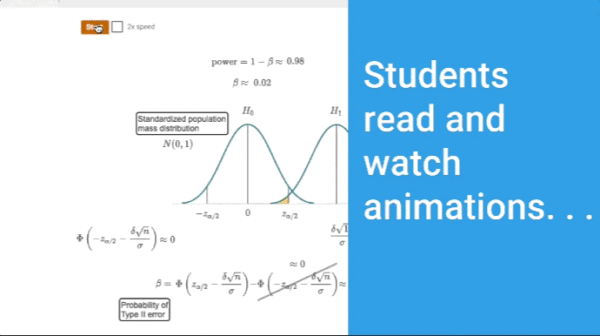2025 zyBooks Guide to Improving Engineering Student Retention
By Nikitha Sambamurthy, PhD, Purdue University, Engineering Education
Table of Contents
I. Introduction
A. The Engineering Retention Challenge
B. Evolution of Retention Strategies
C. Framework for Success
A. Math Support
B. Community Support
C. Dynamic Learning
III. Role-Specific Implementation Guide
A. Provost Level
B. Dean Level
C. Department Head Level
D. Faculty Level
Overview
Engineering education in the United States faces a critical challenge that threatens both institutional success and the future engineering workforce. The American Society of Mechanical Engineers reports that approximately half of the students who begin engineering studies do not complete their degrees (ASME, 2024). This persistent attrition carries significant implications not only for individual students and institutions but also for the nation’s capacity to meet growing demand for qualified engineers, with STEM occupations projected to grow by 11% by 2031 (Yelamarthi et al., 2024).
However, recent research and innovative institutional practices have identified clear pathways to dramatically improve student success and retention. Programs that have adopted comprehensive, evidence-based retention strategies have seen significant improvements in retention rates. For example, the University of Indianapolis demonstrated a 14.5 percentage point increase in first-year to second-year retention through implementation of targeted support programs (Matutes et al., 2024).
The effectiveness of these approaches is demonstrated by recent implementations across diverse institutions. Wright College’s Engineering Success Seminar program achieved a 75% transfer rate to four-year engineering programs within two years (Espiritu, 2024). These improvements have been achieved while maintaining academic rigor and preparing students for successful engineering careers.
Rather than prescribing a one-size-fits-all solution, this guide provides adaptable strategies for each organizational level—from provosts to faculty members. By acknowledging the unique challenges and opportunities at each level, institutions can build coordinated retention efforts that maintain academic rigor while providing essential support for student success.
I. Introduction
A. The Engineering Retention Challenge
Engineering education faces significant hurdles in student retention, with programs retaining only 40-60% of students through graduation (Desai & Stefanek, 2017). The American Society of Mechanical Engineers reports that approximately half of all engineering student attrition occurs during the first year (ASME, 2024). Research by Boyd et al. (2024) has revealed that students often transfer out of engineering programs not due to lack of ability, but rather due to difficulties coping with program demands and inadequate teaching approaches.
B. Evolution of Retention Strategies
Our understanding of engineering retention has evolved significantly over the past decade. Early retention efforts focused primarily on addressing gaps in calculus and physics preparation, managing the transition from high school to college, and addressing lack of interest in chosen majors (Phillips & Schneider, 2024). However, research has revealed that successful retention requires a more comprehensive approach. Espiritu (2024) demonstrates the importance of implementing evidence-based practices such as cohort-based programs, academic and social integration, and belonging seminars.
C. Framework for Success
Drawing from this evolved understanding, this guide presents a three-pillar framework for improving engineering retention:
- Math Support: Effective math support must go beyond remediation to include real-world applications that engage student interest (Yelamarthi et al., 2024).
- Community Support: Programs that focus on building strong communities among first-year students show improved retention outcomes by fostering a sense of belonging (Matutes et al., 2024).
- Dynamic Learning: Modern engineering education requires engaging students through interactive learning materials that support active learning practices (Gordon et al., 2021). This approach maintains academic rigor while increasing student engagement and understanding.
Each pillar of this framework is grounded in research and proven practice. Together, they provide a comprehensive approach to improving engineering retention while maintaining the high academic standards essential for preparing future engineers.
II. Core Strategies
A. Math Support
Research demonstrates the crucial role of mathematics preparation in engineering student success. A study cited by Phillips and Schneider (2024) found that students who excelled in pre-calculus courses had a higher probability of completing their engineering degree compared to those who struggled in higher-level mathematics courses, even when those students began in more advanced coursework.
The Engineering Success Seminar (ESS) at Wright College provides compelling evidence for the effectiveness of targeted mathematics support. Among 630 enrolled students, 620 completed the program with a grade of C or higher, achieving a 93.2% success rate. More importantly, all successful students were retained in the engineering program and either graduated or remained on track for graduation (Espiritu, 2024). This program demonstrated that comprehensive support could increase students’ sense of belonging and self-efficacy in engineering while improving their academic performance.
Successful mathematics support programs take a holistic view of student preparation. As demonstrated at the University of Toledo, effective programs use data-driven approaches to understand incoming students’ needs and provide targeted support rather than focusing on deficits (Yelamarthi et al., 2024). This approach helps ensure that students receive appropriate mathematical preparation while maintaining their confidence and engagement with engineering studies.
Key elements of successful mathematics support programs include:
- Early assessment of student preparation
- Targeted support based on individual student needs
- Integration of engineering applications into mathematics instruction
- Regular monitoring of student progress
- Accessibility of support resources
These elements work together to create a supportive environment where students can develop the mathematical skills necessary for success in engineering while maintaining their motivation and confidence.
B. Community Support
Engineering education can be isolating, particularly for first-year students facing challenging coursework while adjusting to university life. Research demonstrates that sense of belonging is a crucial factor in student retention (Benzel, 2024). Building effective community support requires attention to both academic and social-emotional needs while creating inclusive environments that support diverse student populations.
Successful programs have demonstrated the effectiveness of intentional community building through peer mentoring and support systems. The University of Indianapolis implemented a comprehensive peer mentoring program that matches students based on shared interests and experiences. This thoughtful matching process, combined with regular engagement opportunities, contributed to a 14.5 percentage point increase in first-year to second-year retention (Matutes et al., 2024).
The importance of building inclusive communities is further demonstrated by successful programs at Historically Black Colleges and Universities. Wright College’s Engineering Success Seminar program achieved a 75% transfer rate to four-year engineering programs through comprehensive support and community building initiatives (Boyd et al., 2024). This success demonstrates the power of creating environments where students feel represented and supported.
Effective community support programs typically include:
- Structured peer mentoring systems
- Regular community-building activities
- Professional development opportunities
- Academic support networks
- Social engagement opportunities
- Clear pathways for seeking assistance
When implemented comprehensively, these elements create an environment where students feel supported both academically and socially, contributing to improved retention outcomes.
C. Dynamic Learning
Traditional lecture-based approaches to engineering education, while efficient for content delivery, often fail to engage students in ways that promote deep learning and retention. Modern engineering education requires a more dynamic approach that maintains academic rigor while actively engaging students in the learning process.
Research demonstrates the effectiveness of interactive and hands-on learning approaches. At Harvey Mudd College, first-year engineering students successfully complete meaningful design projects despite their limited engineering knowledge, showing that early hands-on experience can be both engaging and educational (Phillips & Schneider, 2024). This finding challenges traditional assumptions about when students can begin meaningful engineering work.
The importance of engagement is further demonstrated by research on student interaction with learning materials. Gordon et al. (2021) found that students engage more deeply with concise, interactive content compared to traditional long-form text, where they tend to skim rather than deeply engage. Their research showed consistent student engagement with interactive elements across all course sections, with participation rates exceeding 100% due to students reviewing content multiple times.
The effectiveness of interactive learning materials extends beyond engagement to impact student success and confidence. Survey data shows that students report increased understanding of course content and greater confidence in solving engineering problems when using interactive learning materials (Barlow et al., 2024). This suggests that dynamic learning approaches can improve both student engagement and learning outcomes.
Key elements of successful dynamic learning implementation include:
- Integration of hands-on projects from the first year
- Use of interactive learning materials
- Balance of theoretical and practical content
- Regular opportunities for active engagement
- Multiple pathways for learning complex concepts
- Immediate feedback mechanisms
These elements work together to create learning environments that maintain high academic standards while improving student engagement and understanding.
Are your engineering students reading before lecture?
Peer-reviewed research shows that the student passing rate increased 27% when studying with zyBooks. And time spent with their zyBook increased five-fold.
At a time when engineering professors struggle to get students to read before class, that kind of impact is significant.

Learn more about research-based zyBooks versions of trusted Wiley textbooks:
III. Role-Specific Implementation Guide
Successfully improving engineering retention requires coordinated effort across all organizational levels. Support from college management and faculty is crucial to program success (Yelamarthi et al., 2024). Each role within the institution faces unique challenges and opportunities in supporting student success. This section provides specific guidance for each organizational level, based on research and successful implementations across multiple institutions.
A. Provost Level
The provost’s office plays a crucial role in setting institutional priorities and allocating resources to support student success. Recent examples demonstrate how institutional commitment can drive meaningful change. For instance, the University of Indianapolis improved program outcomes through strategic enhancement of their support programs, showing the impact of coordinated institutional efforts (Matutes et al., 2024).
Successful approaches often involve structural changes to better support student success. One effective model, demonstrated at the University of Toledo, involved appointing dedicated student success leadership and integrating student support services under academic affairs. This reorganization elevated the institution’s commitment to retention and allowed for more coordinated support efforts (Yelamarthi et al., 2024).
Key considerations for provost-level initiatives include:
Resource Allocation:
- Investment in high-impact first-year support programs
- Faculty development resources focused on retention strategies
- Technology infrastructure to support student success
- Cross-college initiatives that leverage shared resources
Policy Development:
- Integration of retention goals into institutional strategic planning
- Development of cross-college collaboration frameworks
- Creation of clear assessment standards and metrics
- Establishment of resource allocation models that support sustained improvement
Successful implementation at the provost level requires using data to understand student needs and challenges. This approach helps institutions better assist students while making effective use of limited resources (Yelamarthi et al., 2024).
B. Dean Level
Engineering deans face the challenge of translating institutional retention goals into effective college-wide programs while managing diverse departmental needs and resources. Successful approaches require both strategic vision and practical implementation skills. Phillips and Schneider (2024) describe how effective dean-level leadership involves identifying primary reasons for student attrition and implementing targeted changes to address these issues, while considering both program-specific retention and overall student retention at the college level.
Program Implementation
Successful implementation often involves creating comprehensive support systems. For example, effective learning centers can coordinate peer-based tutoring programs that offer both one-on-one support and study groups. These programs work best when learning center staff collaborate closely with faculty to build referral systems and track student progress (Yelamarthi et al., 2024).
Assessment and Evaluation
Assessment frameworks should measure both immediate and long-term impacts. The Engineering Success Seminar at Wright College demonstrates the importance of comprehensive assessment, measuring not only academic performance but also students’ sense of belonging and self-efficacy within their engineering community (Espiritu, 2024).
Key Strategic Considerations:
Program Development:
- Creation of college-wide support systems
- Coordination across departments
- Resource allocation supporting retention
- Faculty development initiatives
Implementation Support:
- Clear communication channels between stakeholders
- Regular assessment of program effectiveness
- Responsive resource allocation
- Cross-department collaboration frameworks
Success Metrics:
- Student performance indicators
- Retention and graduation rates
- Program participation levels
- Student engagement measures
- Faculty involvement metrics
C. Department Head Level
Department heads serve as crucial bridges between college-level strategies and classroom implementation, requiring both strategic thinking and practical problem-solving skills (Phillips & Schneider, 2024). Their success depends on effectively implementing evidence-based practices including cohort-based programs, academic and social integrations, and belonging seminars (Espiritu, 2024).
Program Development and Implementation
Successful department heads create responsive programs that continuously improve based on student feedback and evolving industry needs. The Engineering Success Seminar at Wright College demonstrates how this approach can increase student belonging, self-efficacy, and confidence in pursuing engineering careers (Espiritu, 2024).
Resource Management
Effective department leadership involves coordinating resources and incentives to support student success. For example, successful programs often involve close collaboration between learning center staff and faculty, including creating incentive systems to encourage student use of support services (Yelamarthi et al., 2024). These collaborative efforts help connect campus experiences with student success (Boyd et al., 2024).
Key Areas of Focus:
Strategic Planning:
- Alignment with college-wide initiatives
- Resource allocation planning
- Faculty development coordination
- Assessment framework development
Faculty Support:
- Professional development opportunities
- Teaching resources and tools
- Mentoring programs
- Collaboration frameworks
Student Support:
- Academic resources
- Mentoring programs
- Career development opportunities
- Support service coordination
The department head’s role requires balancing multiple priorities while maintaining focus on student success outcomes. Success in this role depends on creating systems that support both faculty and students while implementing college-level retention strategies.
D. Faculty Level
Faculty members represent the front line in student retention efforts, directly influencing both academic success and student engagement. Research demonstrates that interactive learning materials can effectively support active learning while maintaining academic standards (Gordon et al., 2021). Faculty can significantly impact student retention through both formal and informal interactions with students.
Classroom Implementation
Successful faculty approaches combine rigorous academic standards with effective support. Survey data shows that interactive elements in course materials can increase both student understanding and confidence in solving engineering problems (Barlow et al., 2024). Beyond formal instruction, faculty can help maintain student enthusiasm for engineering through informal interactions during office hours and hallway conversations, particularly when students are struggling with foundational courses like calculus (Espiritu, 2024).
Building Community
Faculty play a crucial role in building a student community. Successful approaches often include organizing social events and activities that help first-year students build connections with their peers and the engineering community (Matutes et al., 2024). These community-building efforts complement classroom instruction in supporting student success.
Key Implementation Strategies:
Classroom Practices:
- Clear communication of expectations
- Regular feedback mechanisms
- Integration of active learning approaches
- Connection of theory to practice
- Use of interactive learning tools
- Regular assessment of student progress
Student Support:
- Accessible office hours
- Clear communication channels
- Early intervention protocols
- Connection to support resources
- Regular progress monitoring
- Informal mentoring opportunities
Success at the faculty level requires balancing high academic standards with appropriate student support. The evidence shows that faculty can maintain academic rigor while implementing approaches that enhance student engagement and understanding.
How zyBooks helps students at every level persist in their engineering studies
Learn more about research-based zyBooks versions of trusted Wiley textbooks:
IV. References
A. Research Citations
ASME. (2024). Engineering students quit, but retention tactics abound. American Society of Mechanical Engineers.
Barlow, R., Rodriguez, A., Fogg, L., Ratts, L., Adibi, Y., Welter, J., & Fraley, M. (2024). Assessing the effects of an interactive web-native materials science textbook on student self-efficacy. In Proceedings of the 2024 ASEE Annual Conference & Exposition. American Society for Engineering Education.
Boyd, B., Lightner, T., & Mugo, M. (2024). Reinforcing retention: Engaging with HBCUs to identify best practices for graduating low-income students. In Proceedings of the 2024 ASEE Annual Conference & Exposition. American Society for Engineering Education.
Desai, N., & Stefanek, G. (2017). A literature review of the different approaches that have been implemented to increase retention in engineering programs across the United States. In Proceedings of the 2017 ASEE Zone II Conference. American Society for Engineering Education.
Espiritu, D. J. (2024). A multidimensional approach to providing excellent FYE that increases belonging, retention, and success of engineering students. In Proceedings of the 2024 ASEE Annual Conference & Exposition. American Society for Engineering Education.
Gordon, C. L., Lysecky, R., & Vahid, F. (2021). Less is more: Students skim lengthy online textbooks. IEEE Transactions on Education.
Matutes, J., Hacker, S., Herzog, P. S., Spicklemire, S. J., Reid, K., Martinez, J., Leonard, B., & Herzog, J. B. (2024). Peer mentor program strategy for improvement in first-year student retention. In Proceedings of the 2024 ASEE Annual Conference & Exposition. American Society for Engineering Education.
Phillips, J. N., & Schneider, K. A. L. (2024). Strategies for improving retention in a new undergraduate engineering program. In Proceedings of the 2024 ASEE Annual Conference & Exposition. American Society for Engineering Education.
Yelamarthi, K., Powell, E. A., & Faculty. (2024). Engineering student support 2.0: A blueprint for recruitment, retention, and success. In Proceedings of the 2024 ASEE Annual Conference & Exposition. American Society for Engineering Education.
About Dr. Nikitha Sambamurthy
Dr. Nikitha Sambamurthy, Ph.D., is the Editorial Director at zyBooks, where she manages the interactive undergraduate engineering catalog, leads expert teams, designs innovative learning tools, and conducts award-winning research that aims to improve education.
Dr. Sambamurthy holds a B.S. in electrical engineering, and a Ph.D. in engineering education from Purdue University. She was honored this year as one of Purdue’s 38 by 38 for 2024, a prestigious award that recognizes engineering alumni under the age of 38 who have made significant contributions to their fields (honoring Purdue alumnus Neil Armstrong, who was 38 when he walked on the moon). Learn more about Dr. Sambamurthy here.








